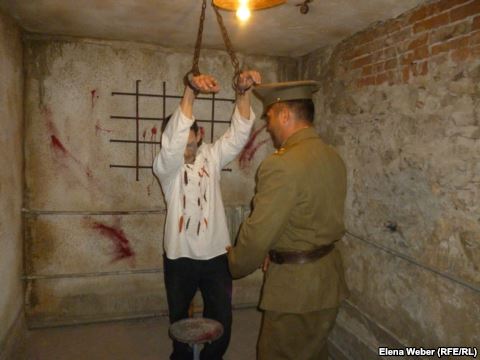However, the Museum of Political Oppression is not the only
Gulag-related ‘attraction’ to blur the boundaries. Grutas Park sculpture
park (also known as ‘Stalin’s World’) in Lithuania, combines extensive
exhibitions featuring Soviet sculptures, artwork and museum artifacts with a
mini-zoo (‘fun for all the family!’). The park also features a recreated Gulag
camp, complete with wooden paths, guard towers and barbed wire fences, among
its exhibits, but original plans to transport visitors to the park packed into
a ‘Gulag-style train’ were blocked. In 2006, Igor Shpektor, Mayor of Vorkuta, –
one of the most infamous outposts of Stalin’s Gulag where over two million
deportees passing through the camp 1932-1954 – was criticized for plans to
charge foreign tourists over £80 per day to ‘holiday’ in an ‘authentic’
Soviet-era prison camp. Shpektor’s plans to renovate an abandoned prison
complex, complete with watchtowers, guards armed with paintball guns, snarling
dogs, rolls of barbed wire, spartan living conditions and forced labor were
condemned by camp survivors as ‘sacrilege’. But Shpektor defended his plans,
arguing this would provide a much-needed cash injection for the depressed
Vorkuta region as: ‘The chance of living in the Gulag as a prisoner is
attractive to many wealthy foreigners … A whole trainload of people turned up
in autumn last year wanting to go to such a concentration camp, for money”.
In 2006, a re-created Stalinist-prison camp near Vilnius,
Lithuania hosted 400 students from 19 EU countries in a role playing exercise designed as a
‘live history lesson to foster deep reflection of the common past of European
nations and people’. During their stay in the camp:
“The students are
“forced” to travel for one hour in an “authentic Soviet truck ZIL157K” to a
forest bunker … Then, for the next two hours, they live through the experience
of being “political prisoners”, which includes being interrogated by NKVD
(security service) officers, shouted at and insulted by the guards. The roles
are performed by professional actors. The “excursion” ends with the
announcement of Stalin’s death and subsequent amnesty.”
Of course, it would be foolish to suggest that a couple of hours
of role-playing equates to the ‘authentic’ reality experienced by Gulag
inmates, many of whom endured lengthy sentences spanning several years or even
decades, having been interred for imaginary or fabricated crimes, not knowing
if they’d ever live to see release, or what the fate of their families had
been. Some of the student participants seemed to agree, with one participant
(rather worryingly!) commenting that:
“I think that
everybody can do this. We really enjoyed the deportation day, but I would
prefer something more difficult, with more blood and maybe lasting for one week
and not just one day.”
So, why does the idea
of ‘experiencing’ the Gulag – an instrument of repression, fuelled by
brutality, where millions of Soviet citizens lost their lives – hold such
appeal for many people? Would you want to spend ‘Saturday night in the Gulag’?
What limits – if any – should be applied to the ‘performative aspects’ of
tourist attractions such as these?
By Dr Kelly Hignett
Kelly is the owner of
The View East blog – here.
For more great updates
and information on blog posts from the likes of Kelly, join us by clicking here.









